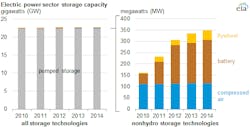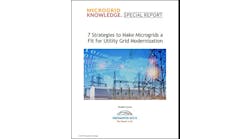Advanced energy storage has more than doubled in the United States over the last five years, growing from 160 MW to 350 MW, according a report today by the Energy Information Administration.
The figures do not include conventional pumped hydroelectric storage, which accounts for 98 percent of electric storage in the U.S. Instead, the report focuses on up-and-comers: compressed air, batteries, and flywheels. Battery storage, in particular, is often included in microgrids.
The EIA noted that U.S. wholesale power markets are beginning to provide a revenue source for advanced storage. Energy storage can sell into certain ancillary services markets. These markets help the electric grid maintain frequency on a second-to-second or minute-to-minute basis or cover sudden and unexpected gaps between supply and demand.
Several Federal Energy Regulatory Commission orders have helped foster these markets.
- Order No. 755 (2011) improves compensation rates in wholesale electric markets for fast-responding resources
- Order No. 784 (2013) adds a requirement for utilities to account for the speed and accuracy of regulation resources (which help balance power system load and generation within minutes) when they determine reserve requirements. The order also requires utilities to report financial and operational information on energy storage assets.
- Order No. 792 (2013) amends an earlier rule to include energy storage technologies and to streamline the time and cost associated with interconnecting new energy resources.
Still, as MicrogridKnowledge.com recently noted here, government has generally been slow in crafting policy for the fast moving energy storage market.
Track markets and policies for energy storage and microgrids. Sign up for the Microgrid Knowledge Newsletter. It’s free.







